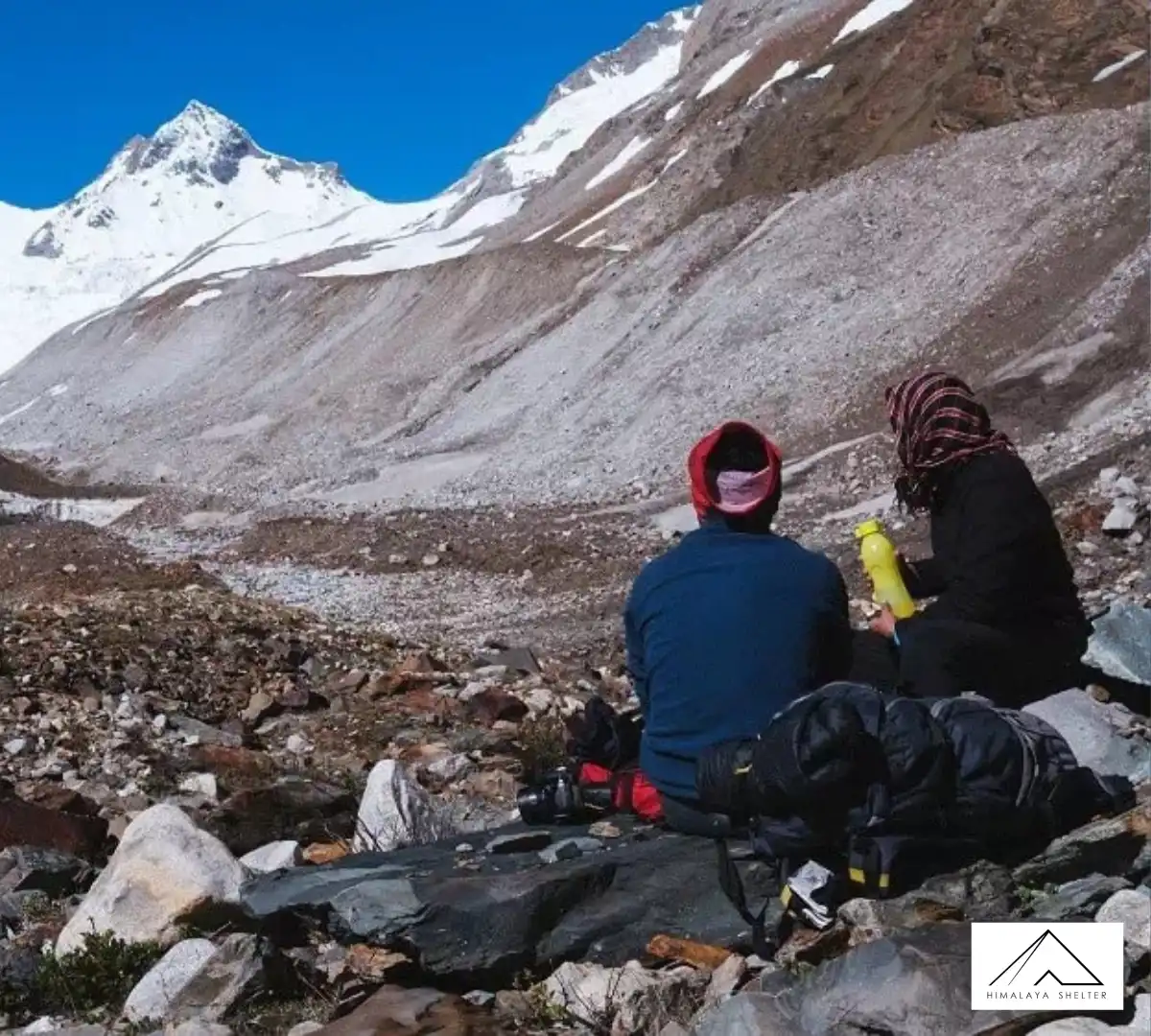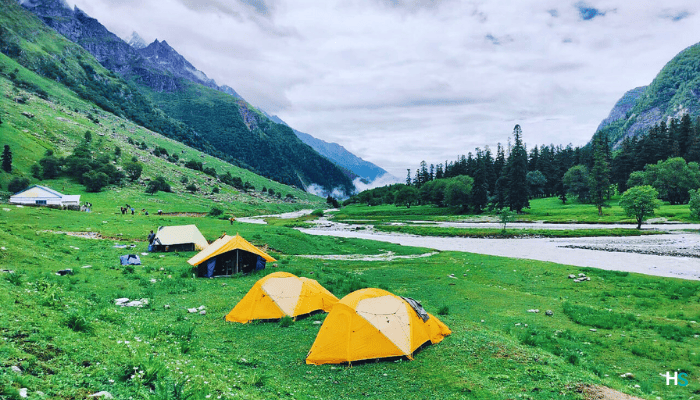
Lamkhaga Pass
TREK DIFFICULTY
Difficult
TREK DURATION
7 Days
HIGHEST ALTITUDE
17,330 feet
GROUP SIZE
12
TREK DISTANCE
76 Km
BASECAMP
Himachal Pradesh
BEST TIME
May to June | September to mid-October
PICKUP POINT
Himachal Pradesh
Lamkhaga Pass Trek Overview:
Lamkhaga pass trek is a breathtaking and high-altitude trek of India. The trek connects Chitkul in Himachal Pradesh to Harshil in Uttarakhand. Walking in the past offers a thrilling experience with magnificent landscapes. The trek passes through glaciers, rivers, towering peaks, and beautiful alpine meadows. Lamkhaga Pass is situated at an altitude of 5,282 m. This high-altitude trek is one the most difficult treks in the Uttarakhand region. The trek passes through challenging terrain, making it ideal for experienced trekkers. Trekkers can start their trek either from Chitkul (Himachal Pradesh) or from Harsil village (Uttarakhand).
Chitkul is a beautiful inhabited village situated near the Indo-Tibet border. This village is known for its untouched beauty and traditional homes. Trekkers can experience Kinnauri culture and the traditional setting near the Baspa River. The trekkers can witness big forests, rhododendron blooming, wildflowers, and grazing lands. If the trekkers are lucky they may get a glare from Himalayan blue sheep. The descent into Harsil is also very beautiful. This small village is situated in Bhagirathi valley. Hashil is known for apple orchards. You can see dense forests, glacial crossings, and unique culture. The Gangotri range gives you a sense of raw and sacred beauty.

History Of Lamkhaga Pass Trek
The history behind this trek is very engaging. This pass is the bond between two cultures. Both Himachal Pradesh and Uttarakhand and the Himalayan States of India. However, the culture, attire, and language are different. This is a lesser-known trekking route due to the difficulty level. But this pass is an ancient route that connected the Baspa valley to the Harsil. This route was mainly used by shepherds and tribal people for trade. Lamkhaga pass trek was also a route for pilgrims to visit Gangotri.
Before independence, locals used the Lamkhaga Pass for bartering various goods like grains, wool, salt, etc. Handicraft was also a big exchange between these two regions. This pass became a bond between two different cultures. Today, you can witness the shared customs and architecture on both sides. This pass came into the picture in the late 2000s among mountaineers and high-altitude trekkers. The expedition teams find this trek as one of the toughest and most thrilling passes of the Himalayan region. The Lamkhaga pass Trek lies near the Indo-Tibet border. It is a very high-security zone and the trekkers require special permits from the Indian Army and Forest Department for this trek.
Highlights Of Lamkhaga Pass Trek
- High-Altitude Trek: Lamkhaga Trek is a very high-altitude trek making it very difficult. This trek is only suitable for high-altitude trekkers. The terrain is very tough and offers a thrilling experience. Trekkers require special snow gear like ice axes, ropes, etc to pass snow-laden passes.
- Beautiful Landscape: The trek starts from Chitkul and ends in Harsil. Trekkers start from Chitkul which is the last inhabitant village of India. After some ascending, the trek starts turning into a snowfield. Trekkers can witness glacial rivers, moraines, etc near the pass. On the other side of the trek, the transition is very beautiful. Trek will lead to big alpine meadows, lush green forests, etc.
- Scenic Villages: Harsil and Chitkul both are very beautiful Himalayan villages. They are culturally rich and the locals are very nice. The architecture is very different from the other cities of Himachal Pradesh and Uttarakhand. You can witness the culture of both the Kinnauri and Garhwali people.
- Less Crowded Trek: Lamkhaga pass trek is still one of the offbeat treks of our country. Harsil and Chitkul are popular villages due to their rich culture. However, not many people know about this trek. This route is still very far away from any commercialization. For experienced trekkers and wilderness lovers, this trek is for you.
Difficulty Level Of Lamkhaga Pass Trek
Lamkhaga pass trek is considered one of the most difficult treks in India. This trek is only for experienced trekkers. It is an extremely challenging trek and is only recommended to people who have experience in glacier travel or mountaineering.
Challenging altitude:
The pass lies at an altitude of 17,320 feet. This much elevation can cause AMS. Getting AMS at this height can be very risky. The thin air can restrict your pace as walking becomes difficult. Your basic body movements become tiring. Trekkers should take at least 1 day at Chitkul or Harsil before starting the trek.
Weather Conditions:
Weather conditions can be extremely harsh on the trek. It is a long trek and predicting weather at high altitudes is difficult. You can face snow storms at the trek. The temperature will usually sub-zero at night even in the summer. The sudden changes in weather can elevate the risk.
Isolated Route:
The route of the trek is very remote. Even the starting is situated in a remote area. Any kind of rescue support in the trek is extremely difficult. Once you start trekking, you will be completely cut off from the network. For any emergency situations, you need to coordinate with the forest department or the Indian Army.
Best Time To Visit Lamkhaga Pass Trek
You can plan your Lamkhanga trek from May to early October. The pass is near the Indo-Tibet border and receives heavy snowfall making it inaccessible in the winters.
- Lamkhaga Pass Trek from May to Mid-June: You can plan your trek in May as you can still experience fresh snow on the pass. Fresh and thick snow enhances the views but can be very challenging. Trekkers will need ropes, crampons, and ice axes to walk on the glacier sections. The weather will be usually dry and cold. The clear skies will provide extremely beautiful views. Snowfall is quite common in the afternoons.
- Lamkhaga Pass Trek from Mid-June to August: This is the monsoon time and this region receives heavy rainfall. The weather conditions will be bad on both Harsil and Chitkul's side. Landslides are quite common making the trail more dangerous. Lamkhaga Pass Trek usually remains closed during the Monsoon. Trekkers should avoid this trek during the monsoon even if the trails are open.
- Lamkhaga Pass Trek from Mid-September to Early October: After the monsoon, the skies become clear and the landscape looks stunning. You can see lush green forests and meadows in the low-altitude areas. The region near the pass usually becomes dry and stable. This is the best time to trek Lamkhaga Pass as there will be fewer snow patches but the trekkers will still need technical gear.
How To Reach Lamkhaga Pass Trek?
You have to reach Chitkul to start your Lamkhaga Pass trek. Alternatively, trekkers can also choose Harsil as their starting point for the trek. Meanwhile, starting the trek from Chitkul is a better option.
Chitkul via Road
For Chitkul, you need to reach Shimla. You can easily find HRTC and private buses from Delhi or Chandigarh to Shimla. After reaching Shimla, look for buses to Reckong Peo. It will take about 8-10 hours. Next morning look for buses from Reckong Peo to Chitkul. There are limited buses from Peo to Chitkul. Hiring a private cab from Shimla to Reckong Peo can be a better option as the buses to this route are very limited.
Chitkul via Train
The nearest railway station to Chitkul is Kalka Railway Station. There are frequent trains from Delhi and Chandigarh to Kalka. After reaching Kalka, take a bus or taxi to Shimla and then start your journey via road.
Chitkul via Air
The nearest airport to Chitkul is Shimla Airport. However, the flights to Shimla airport are limited. Alternatively, look for flights to Chandigarh. Now you can take a bus from Chandigarh to Reckong Peo and then continue to Chitkul.
Things To Carry In Lamkhaga Pass Trek
Lamkhaga Pass Trek is a high-altitude trek located in a very remote area. The trekkers need to carry all essential gear for the expedition.
- Essential trekking gear: Start with a backpack with a steady frame and rain cover. You will need a 50-65 liter bag to carry all your items. If you are using porters then you will need a daypack. Now look for trekking poles that help in reducing stress on your knees.
- Clothing: For packing clothes, start with a base layer. Pack 2 full-sleeve thermal sets. For mid-layer, pack 2-3 quick-dry t-shirts and 1-2 fleece or down jackets. You must pack 1 waterproof jacket, 1 waterproof trekking pants, and 1 warm padded jacket. Also, carry 2-3 quick-dry trekking pants and your undergarments. Don’t forget head, face, and hand protection gear like woolen beanie, UV-protected sunglasses, gaiter, etc.
- Footwear: Carry good trekking shoes; your shoes should be waterproof and ankle-high. Carry camp shoes for the evening. Pack 3-4 woolen and 2-3 synthetic socks. For high-altitude, pack gaiters.
- Personal Hygiene: Pack a toothbrush, toothpaste, and soap. Now pack toilet paper, wipes, and a quick dry towel. Don’t forget sunscreen and moisturizer. Also, pack a quick-dry towel. If you are traveling with friends then you can share items like toothpaste, toilet paper, etc.
- Documents: This trek is situated near the Indo-Tibet border and you will require certain documents for the permit. Carry original and copies of ID proof like Aadhar, Passport, etc. You will also need an inner line permit. Carry 3-4 passport-size photos and a medical certificate.
- Other items like sleeping essentials, food, water, and medical kit will be provided by the trekking team.
Day 1: Start your trek from Chitkul to Dumti. The distance is 9 km and will take 7 hours.
Day 2: Start the trek from Dumti to Gundar. The trek distance is 15 km and will take about 6-7 hours.
Day 3: Start the trek from Gundar to Lamkhaga Pass Base Camp (Kinnaur). The trek distance is 11 km and will take about 7 hours.
Day 4: Start the trek from Lamkhaga Pass Base Camp (Kinnaur) to Lamkhaga Pass and then descend to Lamkhaga Pass Base Camp (Gangotri side). The trek distance is 11 km and will take about 9 hours.
Day 5: Trek from Lamkhaga Pass Base Camp to Kyarkoti. The trek distance is 16 km and will take 8 hours.
Day 6: Trek from Kyarkoti to Harsil. The trek distance is 14 km and will take 6-7 hours. The drive from Harsil to Gangnani will take about 30 minutes.
Day 7: Drive from Gangnani to Dehradun. The distance is 189 km and will take about 8 hours.
Experience the thrill of Lamkhaga Pass Trek with the Himalaya Shelter team. We provide the best trekking services in high-altitude regions. Our guides are highly experienced and will take care of your team. Lamkhaga trek is a very difficult trek; we assure your safety on every step. Himalaya Shelter is offering you a customized trekking experience. You can plan your Lamkhaga Pass Trek as per your dates, group size, and other requirements.
The Himalaya Shelter team focuses on comfort and safety. Our team will also take care of all the permits during your trek. We can customize our meals as per your requirements. Evening snacks and nutritious meals will be provided to our trekkers. Our experienced trekkers will guide you throughout the trek. With the Himalaya Shelter team, you can get the best experience of Lamkhaga Pass Trek.
Day 1: Chitkul to Dumti: 9 KM trek in 7 hours
A vehicle can drop the group from Chitkul to ahead of Rani Kanda. The trek from there is of about 8 to 9 km. The trails pass through flower filled meadows with waterfalls. We may have to cross several brooks.
Day 2: Dumti to Gundar (4,400 m): 15 KM trek in 6 to 7 hours
We follow the Baspa river on its true right bank. An early start is recommended to avoid turbulence in the stream, which we have to cross. Gundar is a grazing meadow and we camp here.
Day 3: Gundar (4,400 m) to Lamkhaga Pass Base Camp in Kinnaur (4,800 m): 11 KM in 6 to 7 hours
On this day, the trail becomes devoid of vegetation. We walk mostly over rocks, snow and ice to reach the basecamp. The camp is usualy over snow here.
Day 4: Lamkhaga Pass basecamp (Kinnaur) to Lamkhaga Pass basecamp (Gangotri Side) via Lamkhaga Pass (5,282 m): 11 KM trek in 8 to 9 hours
Today could be a tough day depending on the ice conditions. The trail is marked by chortens (religious stone mounds), and crosses snow slopes between two ribs and possible crevasses. The climb is fairly steep and we may require a safety rope. The views from the pass are truly rewarding. The rivers flowing on either side of the pass flow into the Bay of Bengal and the Arabian Sea. The path on the other side is also steep and a rope may be needed again.
Day 5: Lamkhaga Pass Base Camp to Kyarkoti (3,820 m): 16 KM trek in 7 to 8 hours
On this day, we cross the river to the true left of the valley. The landscape changes again and vegetation fills it up. The lovely meadow at Kiarkoti makes for a beautiful campsite.
Day 6: Kyarkoti to Harsil (2,400 m); drive to Gangnani: 14 KM trek in 6 to 7 hours
The trail continues along the river Jalandhari through dense forest, waterfalls and streams, which we need to cross. We either camp at Harsil or drive for about 30 min to Gangnani and stay in a guest house. Gangnani is known for its natural hot water spring baths.
Day 7: Gangnani to Dehradun drive: 189 KM drive in 7 to 8 hours
This is the final day of the trip and we drive back to Dehradun.
Inclusions
- Transport support from Harsil to Dehradun: on day 6 and 7 (trekkers need to arrive by themselves at Chitkul or transport can be arranged at additional cost by us)
- Accommodation – At Base Camp, stay at a local homestay or guest house for one night each, which will give you an insight into the authentic lifestyle of the locals.( INR 5000 per person extra for single sharing throughout the trek )
On Trek stay in a 2-person Vango Halo Pro/A-Shape tent, which is to be shared by two trekkers, built to withstand extreme weather conditions and at the same time making you comfortable after a hard day’s trek. - Camping Equipment – specially designed sleeping bags that can withstand harsh weather conditions, foam mattresses. Other safety gear like microspikes, gaiters, an ice axe, and helmets will be provided.
- Medical Kit – our team will be equipped with an extensive medical kit, which our team is trained and experienced to use. Oxygen cylinders are used after they are thoroughly inspected throughout the Trek. Even campsites have large oxygen cylinders as backups.
- Permission - Forest entry charges for Indian nationals (Additional charges will be applicable for international tourists)
- Meals – Breakfast, packed lunch (on trek days), evening snacks, and dinner will be served. A hearty, delicious, and nutrition-filled Veg meals with egg preparation will be provided throughout the trek. (Jain and Vegan Food can also be arranged on prior notification.)There will be a dedicated Kitchen Tent along with a dining tent, which will have a dining table too.
- Our Team – A highly experienced and AMC-certified Trek Leader who will help ensure that the entire trek goes smoothly and safely while navigating the challenging conditions during the trek, and is skilled enough to navigate any medical emergency that can arise during the trek. Local and route Guides who are well-versed with the region and provide an in-depth insight into the local customs and knowledge of the flora and fauna endemic to the region. A dedicated Kitchen staff, which includes a Cook, a helper, and other support staff. There will also be porters and mules to carry common equipment.
- Cloakroom - We have a cloakroom facility available for extra luggage. Every trekker is permitted to leave their luggage behind at no charge.
Exclusions
- Personal expenses like tips, personal medicines, phone calls etc.
- Travel Expenses - Travel expenses from your hometown to the mentioned Pick-Up Point are not included in the trek fee.
From the scheduled pick-up spot to the base camp, we have our own fleet of vehicles like Bolero, Innova, Dezire, or Tempo Traveler (12-seater). This is be shared by trekkers for a pre-decided amount. All vehicles are non-AC. - Personal Equipment - Any personal gear like jackets, shoes, cutlery, or backpacks are not included in the trek fee. We recommend renting them from our Rental Store for an affordable fee. This can be pre-arranged to avoid last-minute hang-ups.
- Offloading - We encourage carrying your backpack to get into the true spirit of trekking. However, if needed, you can opt to offload your personal luggage of up to 12 kgs for an additional cost of INR 500 per bag per day.
- Trek Insurance - A mandatory trek insurance fee is charged in addition to your trek fee. Since most medical insurance doesn’t cover adventure activities, trek insurance offers essential coverage, enhancing your safety without a significant financial burden.
- Buffer day on the trek - We have kept a buffer day on the trek to account for any weather-related delay. If this is utilized, you will need to pay an extra amount to your trek leader.
- Anything apart from inclusions
- Please carry a lunch box for a packed lunch/breakfast to avoid using polythene and Aluminium foil.
Keeping the Himalayas clean is our own responsibility. Reduce the use of Plastic when you are in the abode of the Sacred Himalaya. 🌱
The Lamkhaga Pass trek is considered a strenuous trek suitable for experienced trekkers. Hikers will encounter steep slopes, challenging terrain and high altitudes that require good physical fitness, previous trekking experience and acclimatization.
Trekkers have to obtain permits from the forest department and other local authorities to trek the Lamkhaga Pass. These permits are usually arranged by tour operators or can be obtained directly from the relevant authorities.
You can start your Lamkhaga Pass Trek from Chitkul (Himachal Pradesh). Trekkers can also start the trek from Harsil (Uttarakhand).
Lamkhaga Pass Videos
Lamkhaga Pass
Read More on Lamkhaga Pass
Photo Gallery








Treks by Categories
Treks By Month

Treks By Experience








